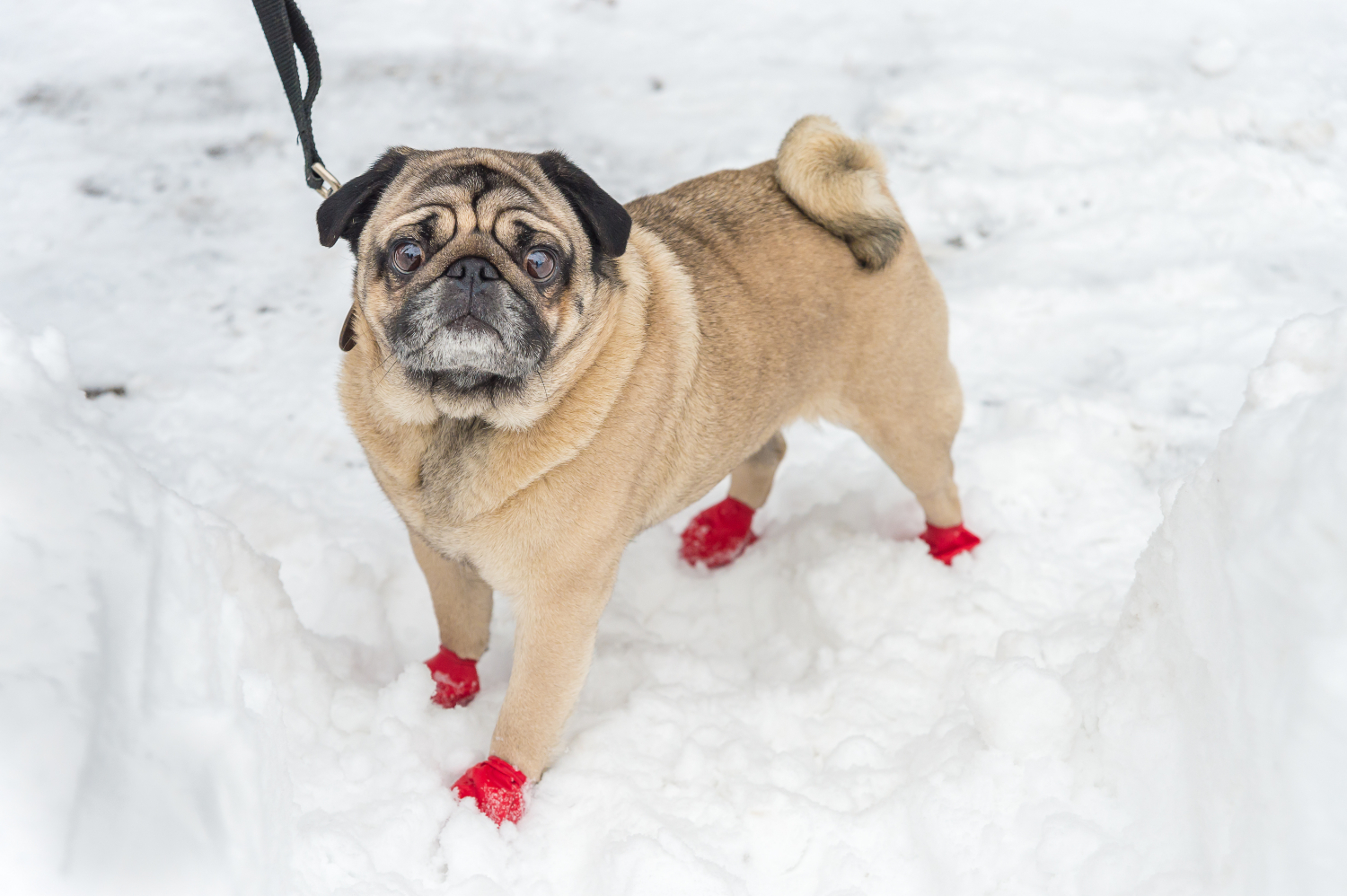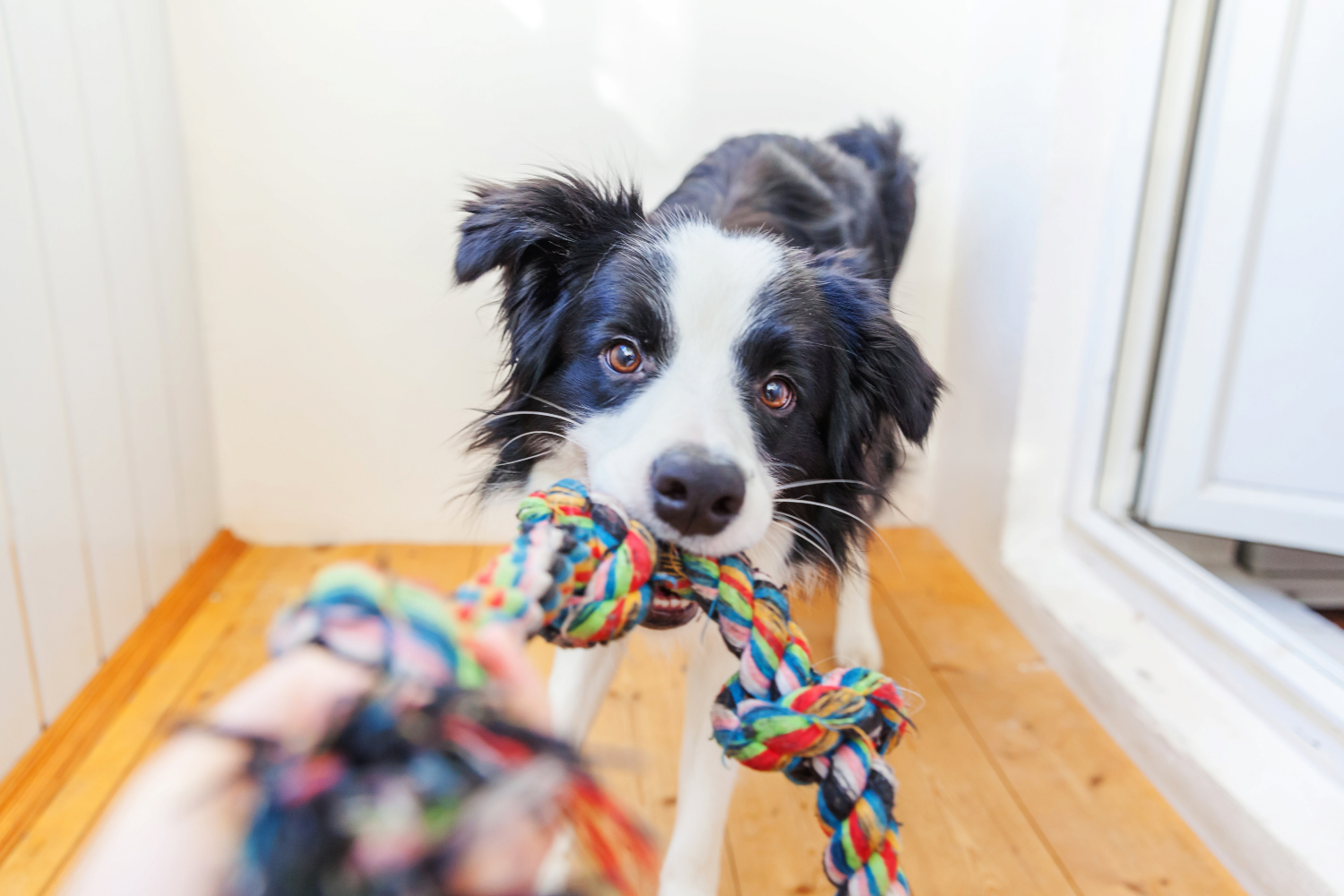
Do I need to give my dog extra care in the winter months?
11th November, 2022
Your senior canine needs special care as the weather gets colder, but how can you help? Petwise shares ways to protect your ageing dog and top tips to ensure they get enough exercise during winter.
As the night’s draw in, the temperatures drop, and we start to feel the chill. It’s not only us humans who get cold, though. Your senior canine is just as likely as you are to shiver and chatter its teeth during winter.
Dogs are susceptible to many of the same health issues in winter as people. Did you know your ageing pooch can get frostbite and hypothermia if you’re not careful in the cold? No pet parent wants to see their loyal friend suffer from medical problems like these!
So, how can you make sure your beloved pet stays warm and safe when you head out on those freezing winter walkies?
Discover some tips to protect their health while outdoors and other fun ways for them to get enough exercise when it’s just too cold to brave the great outdoors.
You’ll also learn how to tell when they’re feeling chilly and where to find pet insurance for dogs to protect your golden oldie in case they need emergency care.
What hazards are there to dogs in cold weather?
When your pooch was a pup, they may have embraced the cold and loved to bound about in the snow. Now they’re older, they might not be so eager to head out the front door on frosty mornings.
That’s because as your dog ages, what was once a winter wonderland now comes with new challenges, and these can take a toll on their health.
During the coldest months of the year, your elderly pet is at higher risk of:
- Injuries from slips and falls on icy steps and floors.
- Joints stiffening and causing more discomfort, especially if they have arthritis.
- Damage to paws due to grit on the ground.
- A dry nose and mouth from the dryer air.
- Hypothermia due to difficulty maintaining their body temperature.
- Frostbite from too much time in the cold.
- Ingesting antifreeze that has leaked from car radiators.
- Falling into frozen bodies of water.
- Putting on weight due to reduced exercise.
If you’re not careful when out and about with your senior canine companion, you might be taking them for an emergency trip to the vet.
This is why pet insurance for dogs is essential throughout every stage of their life. Cover from Petwise can help with the costs of medical treatment when you’re faced with sudden and unexpected bills.
How cold is too cold for dogs?
The coldest temperatures a dog can withstand depends on its breed, but the general rule is that if you’re finding it too cold, your pet probably is, too.
Great Pyrenees, Siberian Huskies, and Newfoundlands come from northerly cold climates and have very thick coats to protect them in snow, so if you own one of these, it might withstand colder temperatures.
Owners of greyhounds and whippets, on the other hand, might want to consider some thermal clothing for their short-haired pets.
Larger dogs can usually tolerate the cold better than smaller dogs, too, so a boxer would be able to spend a bit more time outdoors than a tiny chihuahua.
As canines age, they find it tougher to regulate their body temperature, just like elderly humans. So, the older your pooch gets, the more likely it is to feel a chill.
If your ageing dog has one of the following health concerns, it will find it even tougher keeping itself warm:
- Diabetes
- Kidney disease
- Heart disease
However big or sprightly your old hound is, it’s a good idea to avoid long periods outdoors if the temperature is ever close to or below 0°C.
Don’t forget to consider other factors like wind, rain, snow, or sleet, which can all make your four-legged friend even colder!
Make sure you have pet insurance for dogs in place for your geriatric canine in case they need emergency care due to an accident or injury when out in the cold.
Ways to keep your senior dog protected in the cold
Your dog has been a loyal companion for years, and as a pet parent, you want to protect them and help them live a long and happy life.
So, how can you keep your old friend happy and safe in the colder months? In addition to lifetime pet insurance for dogs, you can make sure they remain comfortable in the following ways.
Limit their exposure in extreme cold
The longer your dog spends outdoors in the cold, the more likely it is to suffer from the health concerns mentioned above.
Of course, they will need to go to the toilet, but a brief 10 minute walk around the block is enough, especially for small or short-haired breeds who struggle to keep warm.
Are you worried about them not getting enough exercise? There are plenty of ways to get your senior canine up and moving inside your home in winter. We have a few ideas a little further down for you to try with your dog.
Protect their paws

Can you imagine walking barefoot across ice and snow? It doesn’t sound very appealing, does it? Well, your ageing dog probably isn’t a fan either.
Not only is it uncomfortable, but paws are more likely to get damaged at this time of year, causing your hound a great deal of pain.
Grit, ice, and snow can all get caught between their tiny toes and pads, so what can you do to keep their feet safe in the cold?
- Trim tufts of hair around toes and paws to stop ice balls from forming.
- Rub paw balm into the pads before you leave home to prevent damage from grit and ice.
- Get your pet some doggy boots to keep them toasty and protect them from cuts.
- Rinse paws thoroughly with a soft cloth and warm water before going indoors to work out any small pieces of grit, which can be harmful to your dog’s health.
Wrap them up
As well as the booties mentioned above, you might want to get your older pet a cosy coat or jumper. Not all breeds will need the extra layer, but short-haired and smaller dogs who struggle retaining heat will welcome the warming addition to their wardrobe.
Make your home winter-friendly
Do you enjoy snuggling inside a cosy blanket on the sofa as the nights draw in and temperatures drop? Does your dog often join you for a cuddle?
Despite the extra warm layer canines have, they are just as susceptible to feeling the cold as we are, especially as they age. Add a soft blanket to your pet’s bed so it can stay warm at night and to stop it from feeling so stiff first thing in the morning.
You might need to adapt other parts of your home as well to make sure your senior dog is comfortable throughout winter and can warm up quickly.
- Put a rug or non-slip flooring down on cold and slippery floors.
- Set up a safe and warm space by a heater or fireplace where your old hound can spend time each day.
- Consider an orthopaedic bed if your senior pet suffers from bone or muscle soreness.
If you’re worried about your older canine keeping warm and comfortable during the winter months or any health concerns related to the cold, speak with your vet.
Alternatively, if you have pet insurance for dogs with Petwise, you can use our vet video consultation service for quick and professional advice.
Prepare for walks in the dark
During winter, it’s much more likely that walkies will happen in the dark, whether you head out before work or in the evening.
Less light can mean there are more risks as drivers can’t always see you. If your dog likes to wander, it can also make it much more challenging to find them again.
The Blue Cross suggests the following ways to keep you both as safe as possible in the dark:
- Walk in well-lit areas whenever possible.
- Keep your dog on your side away from traffic if you need to walk along country lanes.
- Wear reflective clothing – you can get some fantastic bright gear for your canine companion, too.
- Wear a headlamp or carry a torch.
- Walk in a group with other friends when possible.
- Never let your dog off near a road. Only set them free in enclosed areas that they are familiar with.
- Avoid frozen lakes and canals.
- Consider glow-in-the-dark or flashing collars to spot them from afar.
- Take a light up ball for a quick game of fetch in the park and to exercise your dog as much as possible in the cold and warm them up.
Check their lead and collar regularly
Along with the cold often comes rainfall, which means your dog’s collar, lead, and harness are all prone to rust. This can make it trickier to open and close clips. If you find it difficult to put your pet’s walking gear on, it might be time to invest in a new set.
Need some dog walking tips? Check out this video on how to take control of your dog walks and make sure your canine’s harness is fitting as it should.
Speak with your vet
Your ageing canine is more susceptible to the elements than when it was younger, which can mean underlying health issues arise due to the cold.
In addition to taking as many measures as possible to keep your pet safe, you’ll need to monitor its behaviour and watch out for any signs that it’s unwell.
It’s worth taking your senior pooch to the vet for a check-up. They can talk to you about possible medical issues that can worsen during winter and give you some extra tips to keep dogs comfortable and safe.
The vet may also identify any conditions early and prevent them from getting worse, which could save you from having to claim for emergency care costs on your pet insurance for dogs.
How can I tell if my dog is feeling cold?
When temperatures plummet, your pet may still feel the cold, despite your best efforts to keep them wrapped up.
You can tell dogs are too cold if they lift and hold their paws off the ground, start to shiver, and have a hunched position. When they are exposed for long periods or can’t warm up quickly, they may develop hypothermia.
Watch out for these signs:
- Muscle stiffness
- Weakness
- Lethargy
- Less alert
In extreme cases, your senior pet may even become unconscious. If you suspect your faithful friend is suffering from hypothermia, get them to the vet immediately.
This is why lifetime pet insurance for dogs is so important to make sure you can get your hound the care it needs when it needs it most.
What should I do if my dog is very cold?
Ideally, you will keep your pet as warm as possible by bundling it in a doggy jumper and boots and keeping its bed in a cosy place at home.
If it does appear to be shivering and looking hunched, get your ageing dog somewhere warmer and provide blankets, heat, and comfort as soon as possible. If you suspect hypothermia or frostbite, call the vet immediately.
Do dogs need coats in winter?
Most dogs don’t need a coat in the winter, especially if they have thick fur and are very active. However, the older they get, the more difficult it is to maintain warmth.
The Kennel Club recommends a coat if your pet spends a long time outdoors or in extreme cold. It also states that small, slim, and very old dogs are more likely to need one than other canines to prevent hypothermia, so your senior pooch may well benefit from the extra layer of warmth.
Does my dog need boots in winter?
Again, boots aren’t a necessity for dogs, but they can reduce the risk of paw damage and frostbite.
If you aren’t keen on getting your ageing pooch a pair of booties, consider using paw balm and trimming the hair around their toes.
Don’t forget to clean their feet properly before entering the house to get rid of grit and antifreeze on their paws.
How to keep your dog active and fit when it’s too cold to go out
On the coldest days of the year, it’s unlikely that your dog will be doing much walking at all. Older canines would much rather stay indoors where it’s nice and toasty than brave the chill outside.
Less exercise means your pet is at higher risk of becoming overweight, and even more so due to its age. So, what can you do to keep your senior pooch active and avoid it piling on the pounds during winter? We’ve got five ideas to try out below:
1. Change your walking routine
During summer, you and your old dog might have loved wandering through parks and woods late into the evening, but you won’t be feeling the same in the middle of winter.
Your pet still needs to go out to the toilet but keep your walks much shorter than they were when it was warm. You may also want to switch up your schedule and go out a little later in the mornings and earlier at night, so it isn’t quite so cold.
Try to avoid the dark woods and dingy parks and head out into the town centre or along well-lit streets instead. Not only will you both be staying safer, but it will also be nice to try new routes.
2. Watch their diet
With fewer and shorter walkies, your pet is more likely to put on weight. According to the PDSA, when a canine is obese, it’s also more likely to develop other health conditions, which could see you claiming on your pet insurance for dogs.
Reduce their food intake by 10 per cent if their waist starts to disappear and try to keep treats to a minimum.
Keep your pet’s diet high in protein and fibre. These food groups help to maintain a trim waistline while making sure muscles remain strong.
However, if your dog appears to be losing weight rapidly, this could be a sign of something more serious. So you should consult a vet for any concerns.
3. Play indoor games
If your senior dog isn’t getting the exercise they need outdoors, get them on the move inside the house. Lying around all day can cause joints to stiffen and won’t keep them warm as much as bounding about does.
There are plenty of fun activities your pooch will love, including:
- Tug of war
- Fetch with soft toys (on a carpet so your dog doesn’t slip)
- Hide and seek
4. Provide plenty of stimulation
Hours and hours on end spent indoors can become dull for your dog. Unlike us, they can’t entertain themselves with a board game or their favourite show on TV.
As well as the activities mentioned above, you need to keep them mentally stimulated. Try a scavenger hunt by letting them sniff out treats throughout your house.
If you haven’t got one already, consider buying food-releasing toys and puzzle feeders that are perfect to stimulate their brains and keep them entertained for a long time.
5. Teach new tricks
Who said you can’t teach an old dog new tricks? Not us! Canines are intelligent creatures and can learn new skills and commands at any age, just like we can.
In fact, you might be surprised to find your golden oldie is better at picking up new tricks than when it was a puppy. Senior dogs don’t get distracted as much as youngsters and can focus for longer periods.
Learning new skills is another fantastic way to stimulate your hound’s mind and for them to have fun – just choose some of the less strenuous tricks, like the following:
- Shake
- High five
- Walk backwards
- Kiss
- Retrieve an item (like a lead or your slippers!)
- Put away toys
- Speak
If your older pet suffers from eye problems or hearing loss, you might have to get creative in how you teach them, but they can still learn just as well.
Don’t have enough time to train your dog at home? You could enrol your pet in a professional training class. Not only will they be learning from an expert, but it also gets them out of the house and means they can socialise with other canines.
Protect your dog during winter with insurance from Petwise

Are you worried about your senior pooch feeling warm and comfortable during the coldest months of the year? We understand that, as a responsible pet parent, you want the best for your ageing canine throughout its golden years.
Protecting your hound with pet insurance for dogs means you can get urgent care for your faithful friend when they need it most.
Whether they got injured when out on a walk or have suffered from a sudden illness, your insurance can help cover the vet bills.
Why choose a lifetime plan from Petwise for your dog?
- Various levels of lifetime cover to choose from
- No upper joining age limit
- Dental cover as standard
- Fixed excess, no co-payment %
- Senior food contribution
- 24/7 vet video consultations
- Direct payment to vets
Look no further to protect your canine companion this winter. Contact the Petwise team today to get pet insurance for dogs.